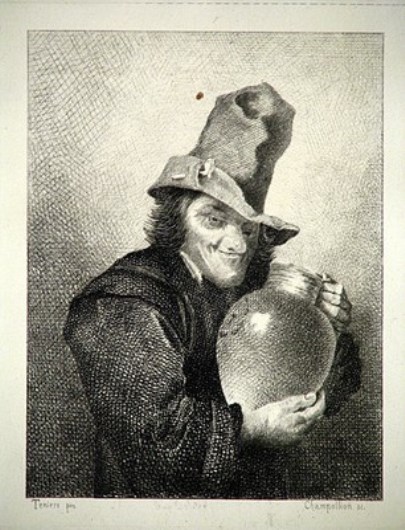
EUGENE ANDRE CHAMPOLLION. 1874
French Impressionist Etching: “L’HOMME A LA CRUCHE”
STILL =
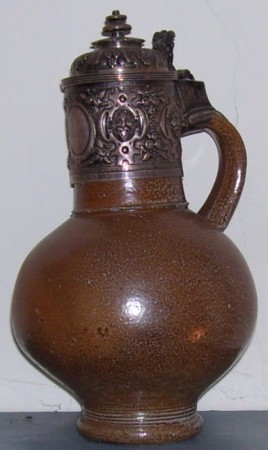
Tiger-ware – Serving steins made in Raeren and shipped to England in the late 1500’s to 1600’s. Called “tiger-ware” due to the spotted finish, [NOT TOO OBVIOUS ON THIS ONE PIECE.] Many had English sliver mounts installed on the neck (it was the rage at the time.) Still very collectable, and expensive in today’s market. Editor’s Note: These jugs often copied over the years. Make certain of the silver marks! Shown: As I haven’t been able to examine this piece, it could be old (both parts) or it could be an old server with newer silver mounts. [JS]
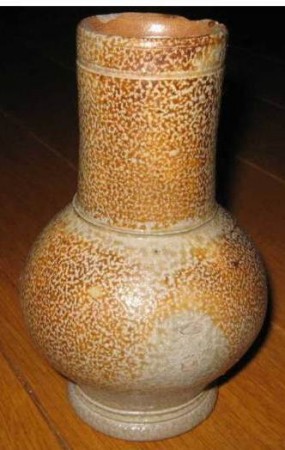
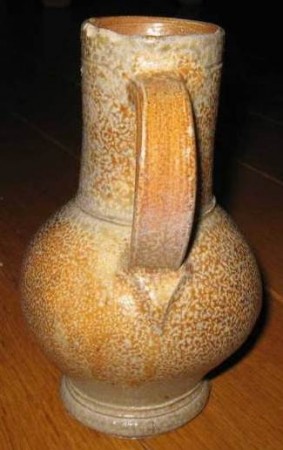
A better example of the finish usually found on Tiger-ware pieces. .5 liter mug from the 1600’s.

General Tilly – by Johan Tserclaes – Subject of many steins including older silver ones, at least one Diesienger and newer pottery versions. He was a Bavarian Catholic hero from “The 30 Years War.”
For more info see: http://www.beerstein.net/samples/die-0068.asp
Tin – A bright natural metal which is the chief component of pewter. Not many all tin steins were made. Shown: Set of 5 antique tin liquid measures, by Chavagnat, Paris, France.
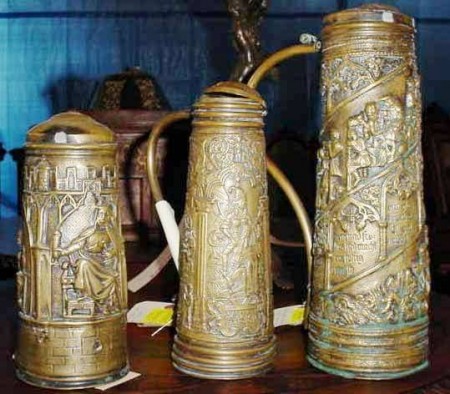
Tinder – ash can “steins” / fireplace display “steins” – These items are not steins at all but display pieces made out of very thin stamped brass. While the scenes were copied from real steins, the seams mostly do not hold liquid (beer), nor will the base, and if full the larger ones’ handles would rip off! I can’t be 100% certain but I think the bottom of the piece are made of asbestos. They could be used for storage of anything not heavy, but one of the primarily uses was for tinder next to the fireplaces in late 1800’s European homes; the other for display on a mantle or the hearth.
Also see: “Not a stein” on the N page in this Compendium.
.
Tiffany – An American silver (and other metals) stein maker. Very sought after in the USA. Shown ttwo up ▲ ▲, a Sterling silver Stein, English Tankard style, late 1800’s. Shown just above ▲: Sterling over cut glass, Art Nouveau style.
See: http://www.steinmarks.co.uk/pages/pv.asp?p=stein1
Toasting – This is what not to do!
Toasting is the strongest and most formal in Germany, Scandinavia and Eastern European countries. In France, Italy and Spain the toast is even given German names. In Spain and Italy, to toast is called “brindar” and it came from the German phrase “Ich bring dir” which means “I bring it to you”.
In France you will hear them say “trinquer” which comes from the German word “trinken” and means “to drink.” And just in case you are wondering where the English phrase “toast” comes from, it comes from the practice of floating a piece of burnt toast on top of the wine of the loving cup (See P”ass Cups.”.The reason for this was that the toast took away some of the acidity of the wine. Back years ago wine wasn’t as good as it is today, so this floating piece of burnt toast worked well to tone down the sharpness of the wine. It was an ancient custom that was popular during the Roman and Greek times dating as far back as the 6th Century B.C. After the bowl was passed around and shared by all the people, the host would be the last one to drink what was left and this included eating the wine saturated piece of toast. This was always done in honor of the guests. (Source: http://www.german-toasting-glasses.com/information_library/history_of_toasting.html)
Toby Fillpot- See “Toby Mug,” just below ▼ ▼
A British Naval” Character Jug.” WWI era. . [FWTD]
Toby jug / mug — English ale pottery (usually) serving vessels originally shaped like Mr.Toby Fillpot (a fictional character) in the form of a seated jovial, overweight male figure. He holds a foaming mug of ale in one hand and also holds a pipe. His tricorn hat forms the pouring spout, and the pottery handle is attached to the rear.
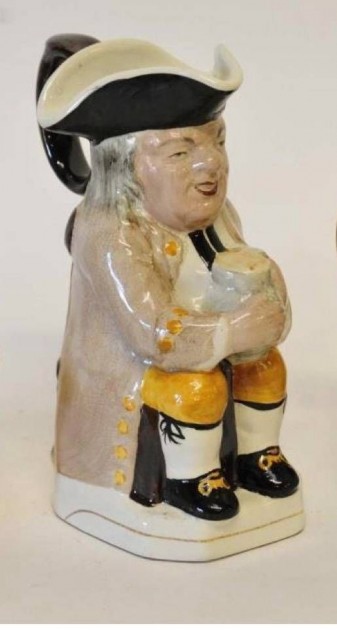
The original Toby Jug, with a brown salt glaze, was developed and popularised by Staffordshire potters in the 1760s. It is thought to be a development of similar Delft jugs that were produced in the Netherlands and the Belgium -French border areas. SEE: Jacquot) and Jacqueline in this compendium.
Similar designs were produced by other potteries, first in Staffordshire, then around England, and eventually in other countries. There are competing theories for the origin of the name “Toby Jug”. It was named after the character of Sir Toby Belch in Shakespeare’s play, Twelfth Night. He was an intoxicated, jovial man. It was named after a notorious 18th century Yorkshire drinker, Henry Elwes, who was known as “Toby Fillpot” (or Philpot). It was inspired by an old English drinking song, “The Brown Jug”, which paid tribute to Toby Fillpot; the popular verses were first published in 1761.
When “Toby’s” became collectable years later, the English started to produce “knock-offs” and ones in smaller sizes.
Shown top : ▲ A great “miniature” painted porcelain “Toby” (this one is really a “character jug”) of an English sailor who was assigned to the “HMS Dreadnought,” the first real modern Battleship ever made.[FWTD]
The ship:Built in Portsmouth dockyard in just over a year, she was the best-armed and fastest battleship in the world when completed in 1906. In the same way as HMS Warrior almost fifty years before, the construction of Dreadnought was intended by Admiral Fisher to deter Britain’s enemy, in this case Germany, through a demonstration of technological excellence and to indicate that any challenge to British naval supremacy would be futile.
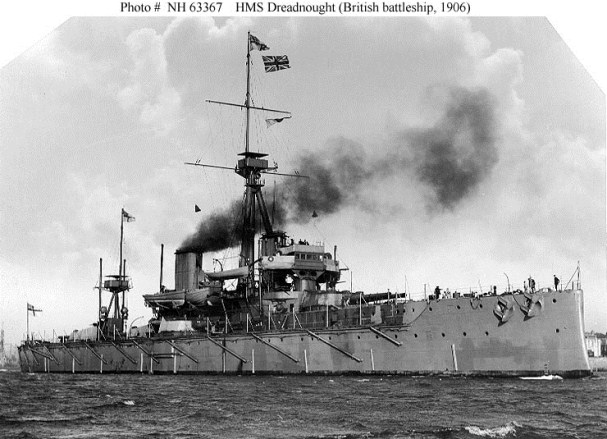
Photo sourse = Google and http://www.history.navy.mil/photos/sh-fornv/uk/uksh-d/drednt9.htm
EDITORS NOTE: NOW-A-DAYS , ALMOSTT ANY CHARACTER MUG MADE IN ENGLAND AND SO MARKED IS CALLED A TOBY JUG INCLUDING UCH ABORTIONS AS THOSES SHOWN BELOW ▼ ▼ !!
Touchmark – Maker’s marks stamped into pewter. “Touchmarks” are to pewter, what “Hallmarks are to silver. The masters would register their “Touch” on a plate that was kept in the Pewter -smiths guild hall. Shown: touch mark on a dated 1618 Pewter Roerken from Lubeck. [FWTD] Also see: “Town Mark” just below▼.
TOWER [A REAL ONE] RARE . SOLD FOR. $1, 750.00 In 9-2014 TSACO
![CR- TOWER [A REAL ONE] RARE . SOLD FOR. $1, 750.00 In 9-2014 TSACO](http://www.steveonsteins.com/wp-content/uploads/2013/07/CR-TOWER-A-REAL-ONE-RARE-.-SOLD-FOR.-1-750.00-In-9-2014-TSACO.jpg)
Tower, or castle steins – There is a sub-set of beer stein collectors who like to purchase steins that look like the towers of the old European city walls, or the keeps of castles. These ARE NOT considered to be real “character steins” by “THE character stein collectors.” Shown: One of the biggest and more elaborate towers made by the “Weygang” firm. Circa 1885. [FWTD]
For many more see: http://www.steveonsteins.com/future-4-the-famile-weygangs-steins-and-servers-1-2
Town Mark — The mark assigned to a city and applied as a quasi-hallmark to denote the location of manufacture, usually a coat of arms, devise or seal of the city.
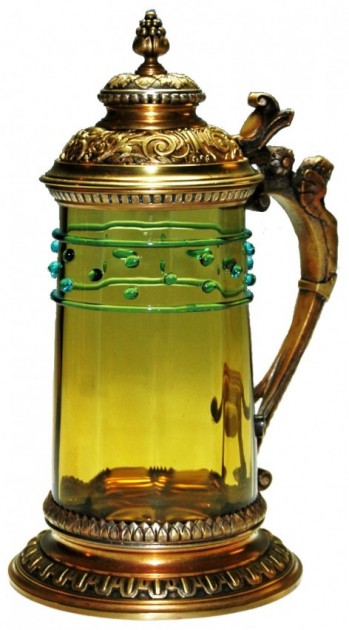
Trails, glass – Long, continuous lines of glass, usually horizontal, applied to the body as additional decoration. Shown: Bronze body by unknown maker, but Austrian I believe. Circa 1880. A very nice looking glass piece [RFA]
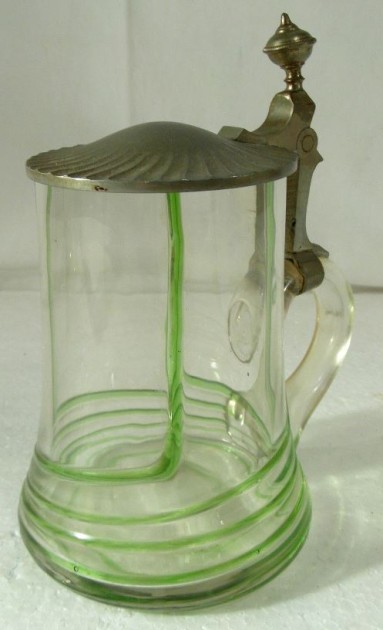
Same idea but on a much less expensive piece.
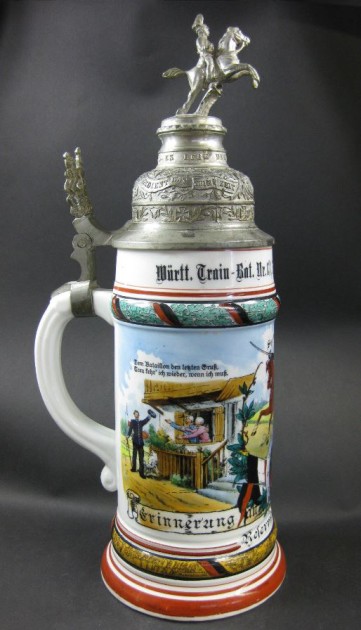
Train – [on reservist steins]- This does not mean train as in our word for a locomotive and rail cars. It means more like a wagon train – these were the supply units for the army and back then they still did use wagons. Steins from these units are fairly collectable. The word used for rail trains in German was Eisenbahn.
Transferware – English PUGs (Print under glaze), started about 18oo and mostly done in blue as shown.
Treen – Made of, or carved from wood. The term is mostly applied to craft items and smaller items made for the home. A term not often used for wooden steins amongst stein collectors. Shown: An olden treen mug (called by seller as being from the 1600s’, but I think it was newer, maybe just left outside to rot). With its “Minor losses,” it sold for $46.00 on eBay in 2008.
.
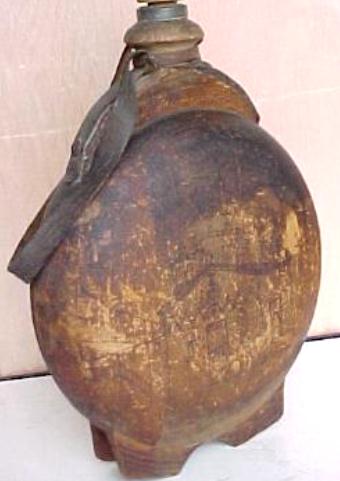
Treen flask – 1921 year, Bulgaria. Souvenir from the Etropole monastery of St. Trinity.
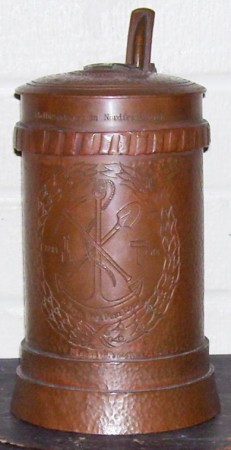
Trench art – Handmade (some by prisoners of war) steins and mugs made out of spent shell and bullet casings, primarily from the First World War; hence the word “trench”, but were continued to be hand made in all the conflicts since, and was also done on Naval vessels. Shown: A very heavy Copper Bavarian Reserve Pioneer Battalion “Trench Art” stein – Has artillery shell rifling as top body band and 1/2 bullet shell on the thumblift. Dated 1916.
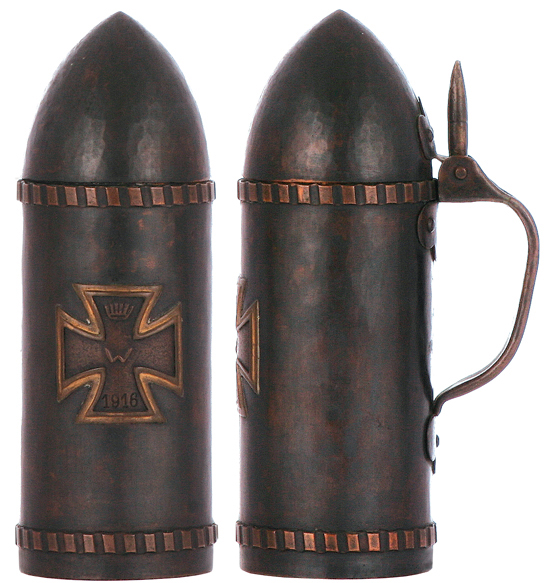
Character stein, Artillery Shell. .5L, brass (stained dark), military commercially made Trench Art, with real WWI “Iron Cross.” [TSACO]
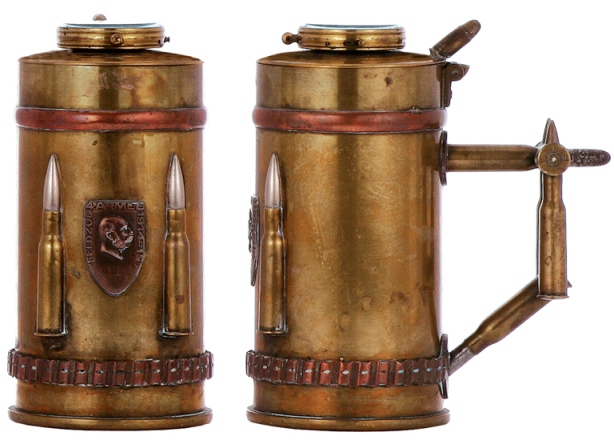
A really well done piece of TA, comes with a compass mounted on the lid (below). (TSACO)
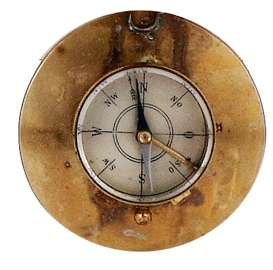
“Trick” drinking vessels – As implied, one has to know how to drink out of them or one will get wet! These include Puzzle Jugs and Mugs, Schapshunds, Yards of Ale, Windmill and Wedding cups, etc.
Shown below▼: A Schapshund – A blown glass schnaps storage vessel, and server made in the form of a dog. 14 CM tall, German 1700’s.
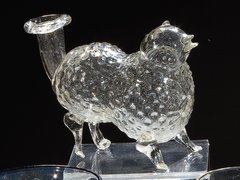
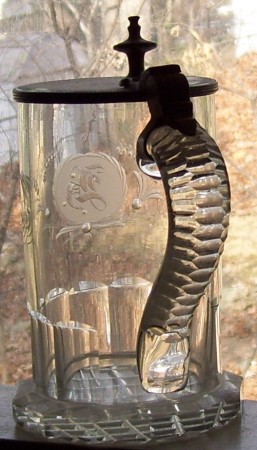
Triple cut handle – Self explanatory. I think most were done in Silesia in the early 1800’s. Jim Sauer disagrees and thinks they were made all over.
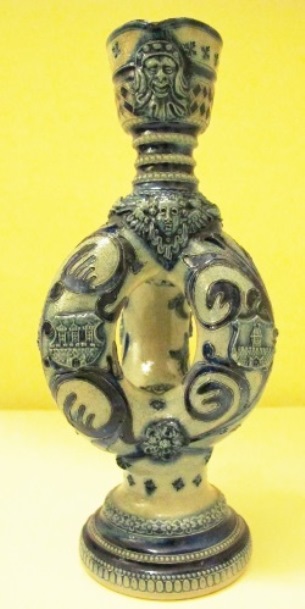
Triple, half-a-ring jug- As described. Shown ▲: A 9 in. tall stoneware “triple, half-a-ring” jug. Westerwald. Ca. 1890.
“Trompeter von Sackingen, Der”
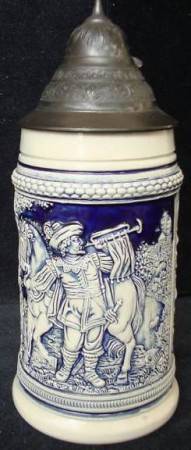
A . J. Thewalt’s version. Standing next to his horse. There must be over 500 vesions or so similar to this one on the market now, by the different German stein maker firms making them for at least 120 years.
.
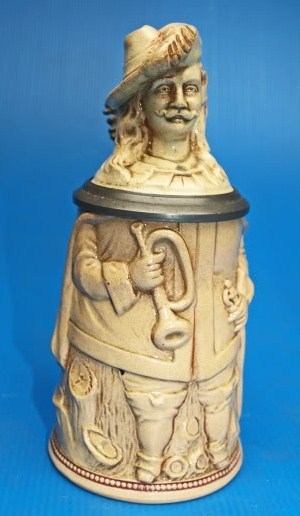
DIESINGER’S TRUMPETER OF SACKINGEN
.
“Trompeter von Sackingen, Der” – Written in 1853, or 1854, or 1855 depending on which reference you are reading by JOSEF VICTOR von SCHEFFEL, “The Trumpeter ” is a humorous and romantic story which became instantly popular. To date it has been through more than 250 printings. And there are at least 100 versions of him and his lady on beer steins.
For much more information see: http://www.thepatriotexchange.com/pss/vonschef.htm
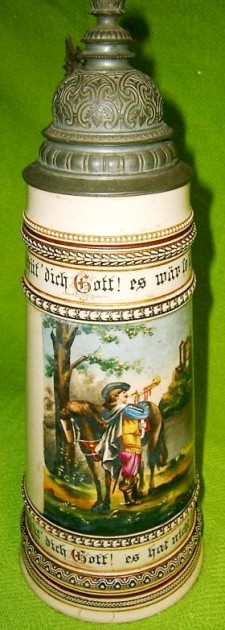
A very nice 2 liter (15.5 inch) version made by Merkelbach and Wick. Circa 1885.
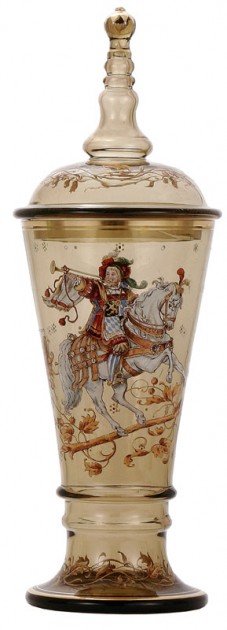
A beautiful hand painted blown glass pokal, circa 1880. Perhaps showing “The Trumpeter” on horseback[?] or it could be any trumpeter, still pretty.
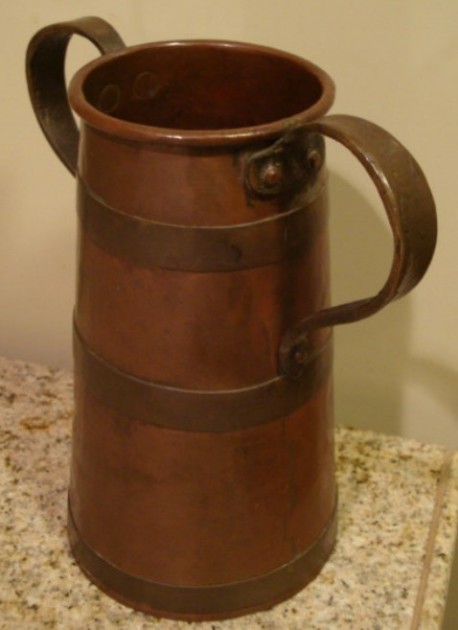
Tula (Russian city – known for its the famous metal working production center 120 miles south of Moscow – the original Batashev factory opened in 1825 by Ivan Grigorievich Batashev. Hand crafted hand hammered copper drinking vessels with brass bands and handles — most often having the Russian made “signature” heart finials on the end of hand forged brass handles. tankard and tavern cups bodies were completely hand rolled, hand hammered, and joined with the finest Russian dovetail construction.
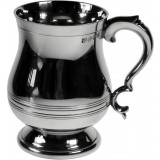
Tulip-shape — Baluster-shaped; usually applied to the shape of English pewter mugs and tankards of the 1700s and 1800s. Shown: A brand new English “Tulip” pewter mug.
Tullenkanne – A large spouted beer jug used for serving. Shown: One dated 1757 from Muskau.
.
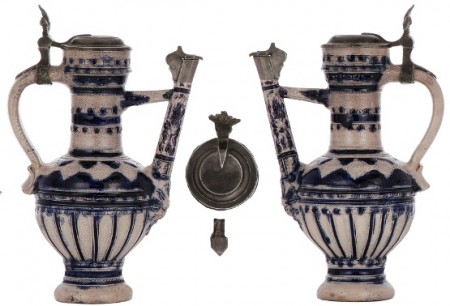
A Westerwälder “Tullenkanne,” 10.0″ ht, early 1700s, blue saltglaze, stamped and relief design, pewter lid & spout cap. [tsaco]
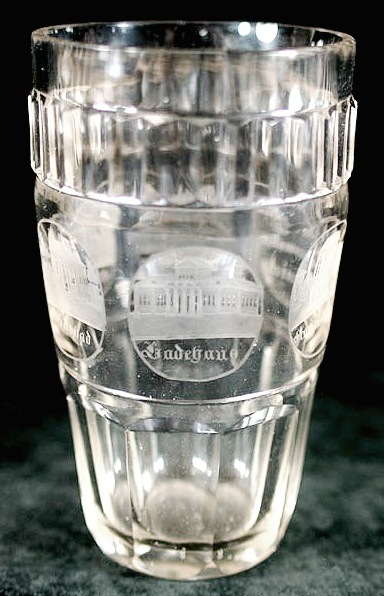
Tumbler – [Official definition]: A drinking glass that has no stem, foot, or handle — so called because such glasses originally had a pointed or convex base and could not be set down without spilling. This compelled the drinker to finish his measure. This term has now been used to mean almost any “glass” made of glass, with glass beakers included. Shown ▲: Advertised on eBay as a Tumbler, this is actually a “Spa Beaker,” a souvenir of a German natural waters, or sea= side spas.
Tureen – Extra large bowl used for soup. The terms “Punch / punsch bowls” were used for wine serving vessels.
SEE: http://www.steveonsteins.com/german-punsch-punch-bowls-a-pictorial-review-awpd
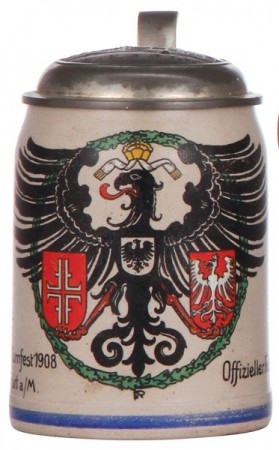
Turnfest – Short for Turner’s fest, a meeting of gymnasts. See 4F steins in this site’s Compendium Shown: Stoneware stein, .5L, transfer – enameled, by F. Ringer, XI. Deutsches Turnfest Frankfurt a.-m. 1908, pewter lid. [tsaco]
Tusnelda – The wife of Hermann the German. Shown: Detail from a 1/2 liter pottery stein entitled “Hermann’s departure from Tusnelda.”
For more info on Hermann, please see “Hermann’s Story” = http://www.steveonsteins.com/hermanns-story
T.W. steins – Steins marked as such but made for and sold by a Nurnberg souvenir distributor, Theodor Wieseler. His dealership is advertized on this stein, made in the form of an outdoor advertising pillar, for all the advertisers on it as gifts (?) This one stein lead me and Mr. Chuck McKitrick to discover who “T.W.” was for SCI’s edification many, many years ago.
See “Stein Marks” for much more info, but look under ‘Wieseler’ as there is little [if any] cross referencing = http://www.steinmarks.co.uk/pages/pv.asp?p=stein1
CR- TWENTY FOUR (24) CARAT CLUB
[1] STEIN PUT MUG WITH IT. NOT CERTAIN WOOD BASE WAS EVER ATTACHED
![CR- 24 CARAT CLUB [1] STEIN PUT MUG WITH IT. NOT CERTAIN WOOD BASE WAS EVER ATTACHED](http://www.steveonsteins.com/wp-content/uploads/2013/07/CR-24-CARAT-CLUB-1-STEIN-PUT-MUG-WITH-IT.-NOT-CERTAIN-WOOD-BASE-WAS-EVER-ATTACHED-333x630.jpg)
REAR NO THUMBLIFT NOR CERTAIN WOODEN BASE WAS EVER ATTACHED
![CR- 24 CARAT CLUB [2] REAR NO THUMBLIFT NOR CERTAIN WOODEN BASE WAS EVER ATTACHED -1](http://www.steveonsteins.com/wp-content/uploads/2013/07/CR-24-CARAT-CLUB-2-REAR-NO-THUMBLIFT-NOR-CERTAIN-WOODEN-BASE-WAS-EVER-ATTACHED-1-375x630.jpg)
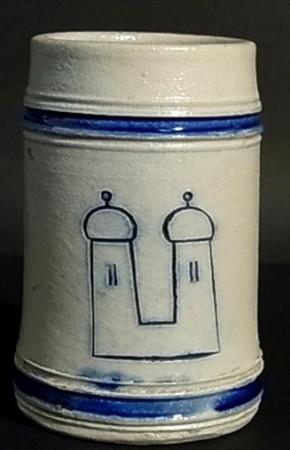
Twin Towers of Munich – Refers to the two towers of the famous Frauenkirche (full name Dom zu Unserer Lieben Frau, “Cathedral of Our Dear Lady”) in Munich city. Shown▲: A 3 inch Westerwald miniature souvenir.
Twisted stem; Air twist; Wormed glass or Opaque twist
Stems on wines, pokals and beakers; stems that have ribbons of colored -mostly white- glass inserted into the clear glass stem and them twisted into a intricate design. Air twist glasses were also known as “wormed glasses” in the mid 18th century England due to their appearance; almost as if a worm had crawled through the glass, leaving a trail behind it where it had “eaten” the glass.
Shown above ▲: A twist around twist (or “double twisted” stem) on a “colorless” 11 inch tall roemer with twisted stem and engraved scene of deer. These were made in the early 1900’s in various sizes and engravings by Josephinenhütte. Theirs had a very distinctive pattern like a barber pole effect; much different looking than the older English ribbon twist wines. [FWTD]
See http://www.steveonsteins.com/josephinenhutte-glass-drinking-vessels-at-the-s-m-t-draft-3-30
also: Ribbon stems.
Two handled mugs / steins / servers – See: “Pass cups” @ http://www.steveonsteins.com/pass-cups-a-short-history-new-12-26-10
Also see four photos below.
![BLIND - Gerz Amphoras 3[1]](http://www.steveonsteins.com/wp-content/uploads/2010/07/BLIND-Gerz-Amphoras-31.jpg)
.
![BLIND JUSTICE -Gerz Amphoras 2[1]](http://www.steveonsteins.com/wp-content/uploads/2010/07/BLIND-JUSTICE-Gerz-Amphoras-21.jpg)
Two handled wine servers – These are usually seen in Blue-gray Westerwald stoneware. The Gerz firm was the maker of this one. Shown: A 20 inch (?) tall one showing “Lady Justice” (incorrectly called “Blind Justice” on both sides. (Photos comps of Robin L.)
From Wikopedia (edited): Justitia is most often depicted with a set of scales typically suspended from her right hand, upon which she measures the strengths of a case’s support and opposition. She is also often seen carrying a double-edged sword in her left hand, symbolizing the power of Reason and Justice, which may be wielded either for or against any party.
Since the 15th century, Lady Justice has often been depicted wearing a blindfold. The blindfold represents objectivity, in that justice is or should be meted out objectively, without fear or favour, regardless of identity, money, power, or weakness; blind justice and impartiality. The earliest Roman coins depicted Justitia with the sword in one hand and the scale in the other, but with her eyes uncovered.[3] Justitia was only commonly represented as “blind” since about the end of the 15th century. The first known representation of blind Justice is Hans Gieng’s 1543 statue on the Gerechtigkeitsbrunnen (Fountain of Justice) in Berne.[4] Instead of using the Janus approach, many sculptures simply leave out the blindfold altogether. For example, atop the Old Bailey courthouse in London, a statue of Lady Justice stands without a blindfold;[5] the courthouse brochures explain that this is because Lady Justice was originally not blindfolded, and because her “maidenly form” is supposed to guarantee her impartiality which renders the blindfold redundant!
Tyge [or Tyg (lees comon)] – The English word for pottery or stoneware drinking vessels with more than one handle, used as a “pass cup.”
See: http://www.steveonsteins.com/pass-cups-a-short-history-new-12-26-10
.
The Germans and the Dutch used this style as early as the 16th century.
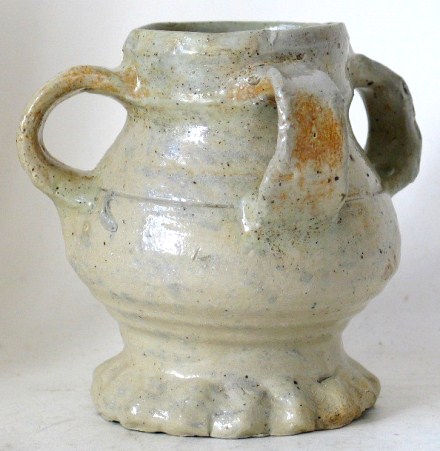
A 1500’s Cologne “pass cup” (A stoneware Tyge.) Rare if not restored.
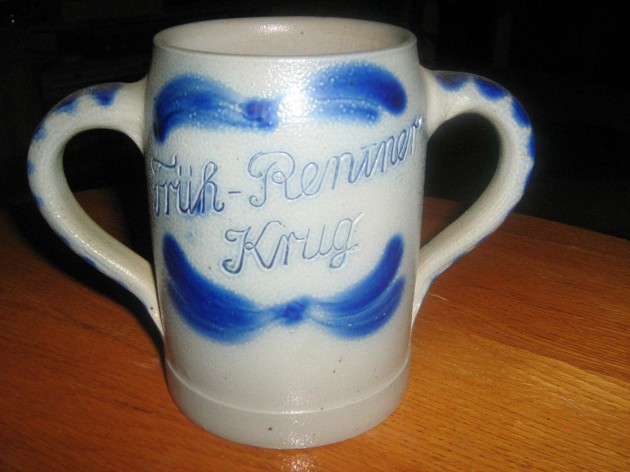
A late 1900’s Westerwald stoneware version of a tyge.
As one can see below the custom is still ongoing, albeit with the ‘titty pinch’, a little more risque. A Ca. 2000 German tyge (pass cup extraordinaire!).
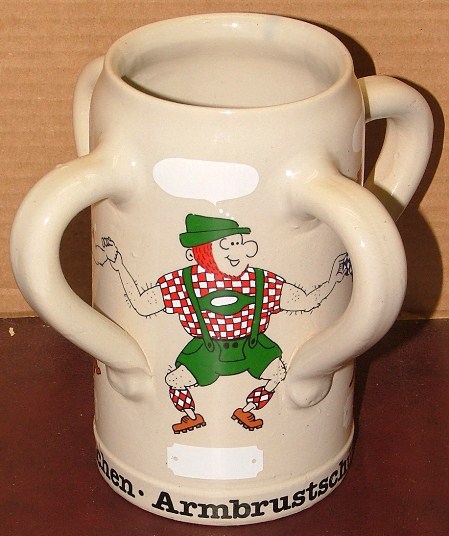
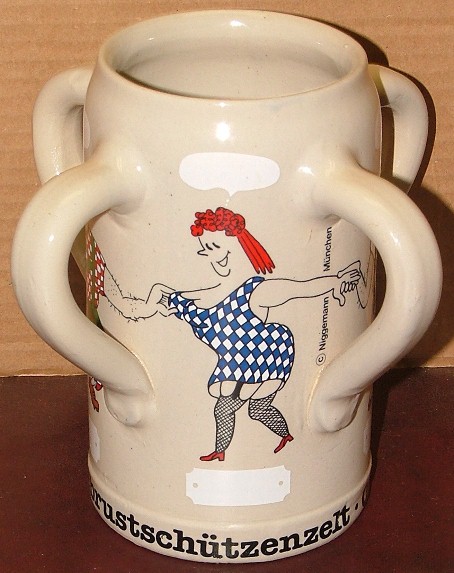
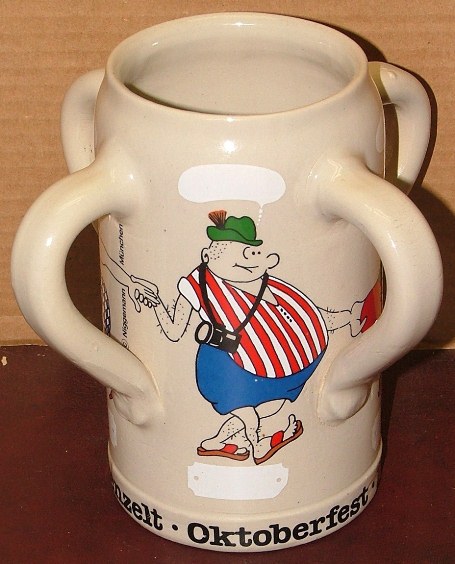
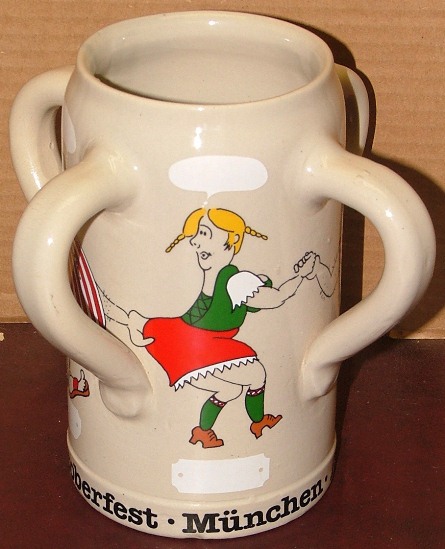
.
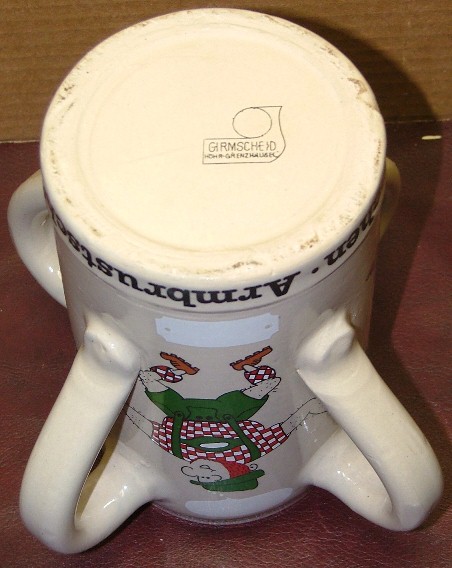
[END – NOSOK – 58 – R5]
WISH TO CONTACT ME ? Steve (Stephen) =


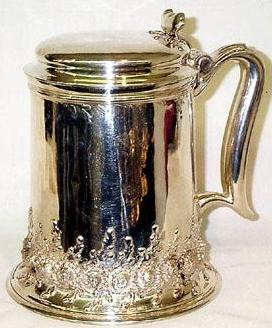
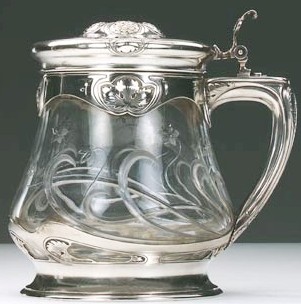
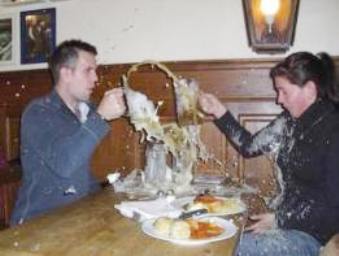
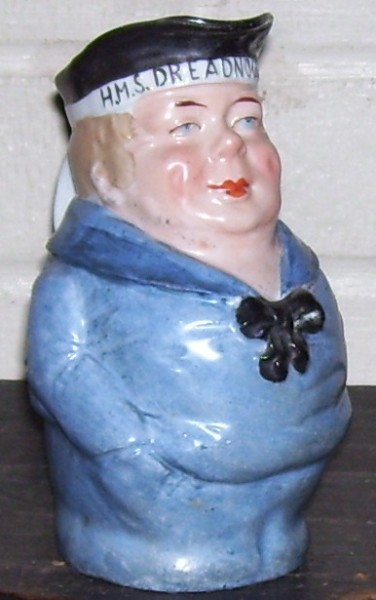
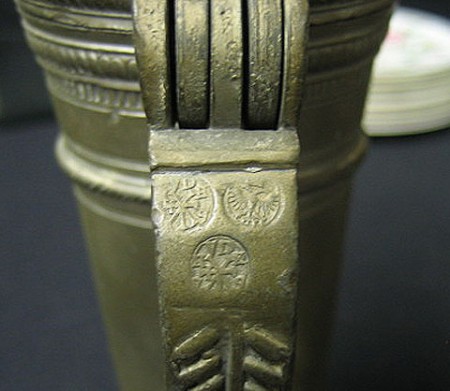
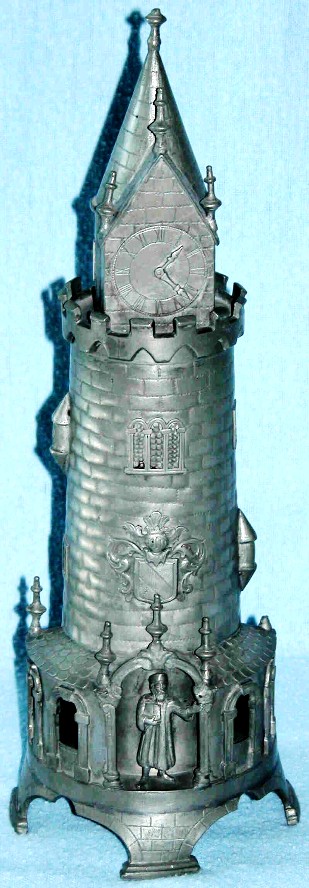
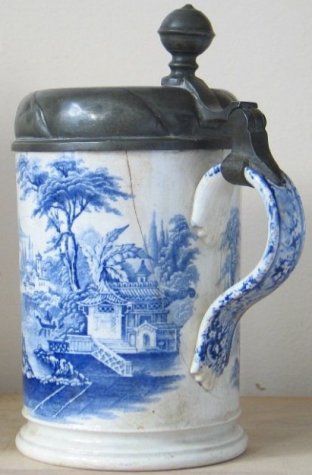
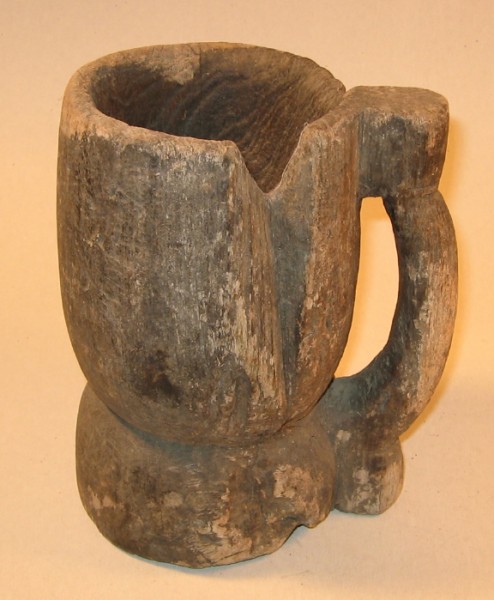
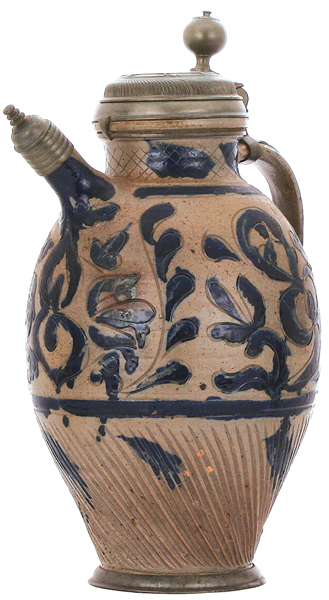
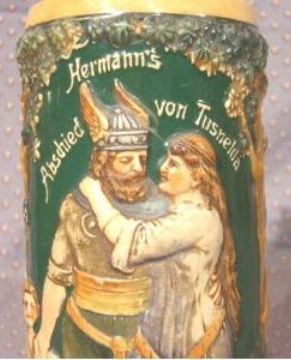
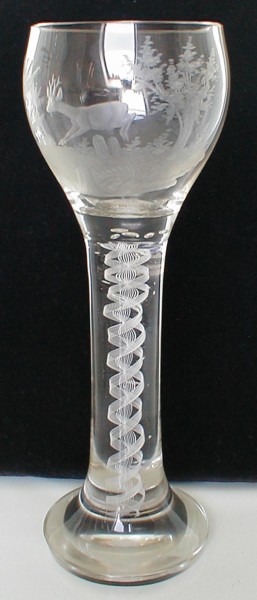
Leave a Reply